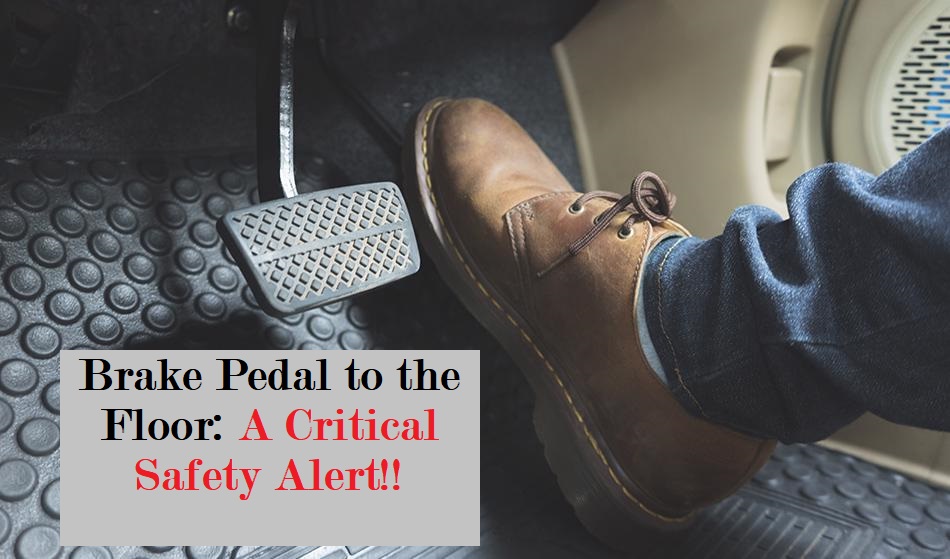When Your Brake Pedal Goes to the Floor: Don’t Ignore the Warning Signs

As you drive, your safety and the safety of others depend on a well-functioning brake system. Imagine a scenario where you press the brake pedal, and it sinks all the way to the floor without offering the expected resistance. This is a serious issue that demands immediate attention. In this blog, we’ll explore the potential causes and risks associated with a brake pedal going to the floor, emphasizing the importance of addressing this problem promptly to ensure your safety and the safety of others on the road.
1. Understanding the Gravity of the Situation: When you press the brake pedal, it initiates a complex hydraulic system that converts the pressure from your foot into stopping force at the wheels. If the pedal goes to the floor, it’s a clear indication of a brake system failure. The reasons behind this issue can vary, but they all require prompt action.
2. Potential Causes: Several factors could lead to a brake pedal sinking to the floor, and each has its level of severity:
a. Brake Fluid Leak: One of the common causes is a leak in the brake fluid system. Brake fluid plays a crucial role in transmitting the pressure from the pedal to the brakes. If there’s a leak, the fluid level drops, reducing the pressure and causing the pedal to sink.
b. Air in the Brake Lines: Air can enter the brake lines during repairs or due to a leak, leading to a spongy feeling in the brake pedal and potential loss of braking power.
c. Master Cylinder Failure: The master cylinder is the heart of the brake system. If it malfunctions, the hydraulic pressure required for braking might not be generated, causing the pedal to sink.
d. Brake Caliper Issues: Stuck or malfunctioning brake calipers can prevent proper brake pad contact with the rotor, leading to a soft pedal.
3. Risks and Dangers: Ignoring a brake pedal that goes to the floor can have dire consequences:
a. Extended Stopping Distances: With reduced braking power, your vehicle will take longer to come to a stop, increasing the risk of accidents, especially in emergency situations.
b. Loss of Control: The inability to stop or slow down effectively can lead to loss of vehicle control, endangering yourself, passengers, and others on the road.
c. Accidents and Collisions: Brake system failures are a significant contributing factor to accidents and collisions, which could result in severe injuries or fatalities.
4. What to Do When the Brake Pedal Goes to the Floor: If you experience a sinking brake pedal, follow these steps:
a. Remain Calm: Stay composed and focused to handle the situation effectively.
b. Downshift and Use Emergency Brake: If you’re driving a manual transmission vehicle, downshift to lower gears to slow down. Additionally, engage the emergency brake gradually if it’s safe to do so.
c. Pull Over Safely: Signal and steer your vehicle to the side of the road or a safe location as soon as possible.
d. Check Brake Fluid Level: If you have the knowledge, check the brake fluid reservoir for any signs of leaks or low fluid levels.
e. Avoid Driving: Under no circumstances should you continue driving with a faulty brake system. Tow your vehicle to a trusted mechanic or repair shop.
5. Seeking Professional Help: A brake system is a complex and vital safety component of your vehicle. Therefore, it’s crucial to seek professional help immediately when you encounter a sinking brake pedal. Qualified mechanics can diagnose the problem accurately and perform the necessary repairs.
Conclusion: Your brake system is not something to take lightly. If your brake pedal goes to the floor, it demands your full attention. Ignoring the warning signs can lead to dangerous situations, accidents, and potential harm to yourself and others. Prioritize your safety and that of others on the road by addressing brake issues promptly. Remember, a well-maintained brake system is essential for confident and secure driving experiences.
Picture Courtesy: Google/images are subject to copyright








